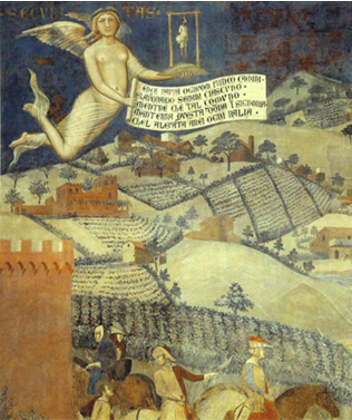Amy Strecker and Amanda Byer from UCD’s Sutherland School of Law explain why landscape is more than a view and why protecting place-based understandings of land is critical for sustainable land use.

The word ‘landscape’ often conjures the aesthetic features of nature as scenery, such as a landscape painting, or a landscaped garden or park. But landscape originally referred to representation not just in the pictorial sense, but in the political sense as well– a polity or distinctly organised region based on particular people-place relations.
Excerpt from engraved frontispiece of Leviathan by Thomas Hobbes (1651).
It’s in the name: landscape, land scaped or shaped by people, where shape refers to the physical form of the land reflecting the community’s impact on the environment, as well as the shaping of that community by those interactions, giving rise to identity, community ties and customary practices. Landscape can also be translated as landship, a word no longer in use but which signified the culturally specific people-place dynamic inspired by the land itself. Landscapes were therefore locally-based understandings of land based on its limits - dynamic, contested but always linked to the physical environs.
As the cultural dimension of land, landscape is an umbrella term for all those non-proprietary interests relevant to access, use and identity. These locally embedded practices, institutions and laws were consolidated as part of the common law of the realm, which regulated land in England and later throughout the British Empire. Landscapes were now subject to property rights, as land was seen as unpopulated nature capable of enclosure and extraction on a mass scale.

The humanising of landscape in law, which had previously been tied to nature protection, often excluding local communities, brings the legal understanding of landscape closer to those earlier origins, when community justice, body politic and custom were embedded in the concept. Landscape law includes protection measures, such as those contained in the World Heritage Convention and other international conservation instruments, but also an acknowledgement of the rights of communities to participate in the decisions affecting their landscapes, as evidenced in the European Landscape Convention.
However, while landscape’s legal identity has been partially recovered at the level of norms, there is still a gap at the level of practice. Procedural rights are fundamental to legitimate landscape law, yet the emphasis in the European Landscape Convention (ELC) rests on participatory rights and extending participatory rights in national law beyond environmental aspects to also include the cultural and place-based dimensions of landscape remains a challenge in many states. This is because in practice, landscape is often considered in preservationist terms rather than substantive ones dealing with peoples’ relationships to the places where they live.
The ELC presupposes a functioning (deliberative) democracy where decision-making is representative – an ephemeral goal for many states. If landscape’s legal identity is ultimately linked to the notions of custom and commons, and to use and access, we need to be able to articulate these rights in substantive terms when faced with unjust situations, such as when the state approves a project that is environmentally, socially and/ culturally destructive.
The discursive influence of the ELC over the past two decades illustrates the societal role of law in acting as a reference point and providing a vocabulary for collective action. But as a tool for accessing justice, we need to look beyond the ELC and insert landscape within national planning procedures, cultural heritage law, and human rights norms.
Importantly, this also involves scrutinizing property, both the idea of land as property, and the interpretation of property rights in land. Property is at the root of much landscape injustice, or at least the way in which property has become abstract and placeless. Viewing land in abstract terms can mean we treat land as homogenous and interchangeable, rather than lived-in and subject to diverse values.
Local and place based perspectives are key. Local communities are often attuned to the ways global problems like biodiversity loss and climate change manifest locally and threaten sustainable land use and livelihoods. Place-based interests in land, returning to an understanding of land that is locally based and cognisant of local limits, could help us address many of the crises threatening sustainability today, which find their roots in exceeding the known limits of ecosystems, and the planet itself.
These issues are at the forefront of a current ERC-funded project we are working on, which involves re-examining property’s relationship with the landscape, and the law’s role in defining land.
Essay first published 3 January 2024.
About the authors
Amy Strecker is Associate Professor at UCD Sutherland School of Law and PI of an ERC project PROPERTY[IN]JUSTICE on land, property and spatial [in]justice in international law. Amy has worked extensively on the role of law in landscape governance, combining cultural heritage norms with environmental law and human rights. A continuing thread throughout her work has been access to justice for communities facing landscape degradation and destruction.
Amanda Byer is a postdoctoral researcher in the PROPERTY[IN]JUSTICE project researching the conceptualisation of property rights in law and its capacity to facilitate spatial justice and injustice. Originally an environmental lawyer, Amanda’s PhD research at Leiden University involved a legal geographical analysis of the environmental and cultural heritage laws of the Caribbean and reflects her interests in landscape, law and spatial justice.
About the series
The A-Z of Environmental and Sustainability Research is a new series of short essays by UCD postdoctoral and postgraduate researchers, technical and research support staff, about their work. The series is developed and curated by the Earth Institute Associate Member Committee led by Hannah Gould, a PhD student at BiOrbic and the UCD School of Architecture, Planning and Environmental Policy, and Earth Institute Communications and Engagement Officer Liz Bruton. If you'd like to submit a piece for the series do get in touch!
Find out more about the Anthropocene with Nick Scroxton, Bees with Katherine Burns, Cannabis with Caroline Dowling, Degrowth with Ciarán O'Brien, Education with Georgina Fagan, Finance with Shane McGuinness, Gaia with Federico Cerrone, Hydrometry with Kate de Smeth, Innovation with Hannah Gould, Justice with Lauren Minion, Kelp with Priya Pollard, Landscape part 1 with Tomas Buitendijk, and Landscape part 2 with Amy Strecker and Amanda Byer in our latest essays.
Further reading
Strecker Amy, Landscape and Legal Identity, The Future of the European Landscape (ELC+20), Landscape-E, the quarterly newsletter of the Landscape Observatory NÚM. 71, October-December 21.
Strecker, Amy, Landscape Protection in International Law (Oxford University Press, 2018).
Olwig, Kenneth R, Recovering the Substantive Nature of Landscape, Annals of the Association of American Geographers, 1996 Annals of the Association of American Geographers 86(4): 630-653.
Byer, Amanda, Before Property: A Prehistory of Property Rights in Land (December 5, 2022). UCD Working Papers in Law, Criminology & Socio-Legal Studies Research Paper No. 10 / 2022.
Council of Europe, The European Landscape Convention (Florence, 2000).


.jpg)